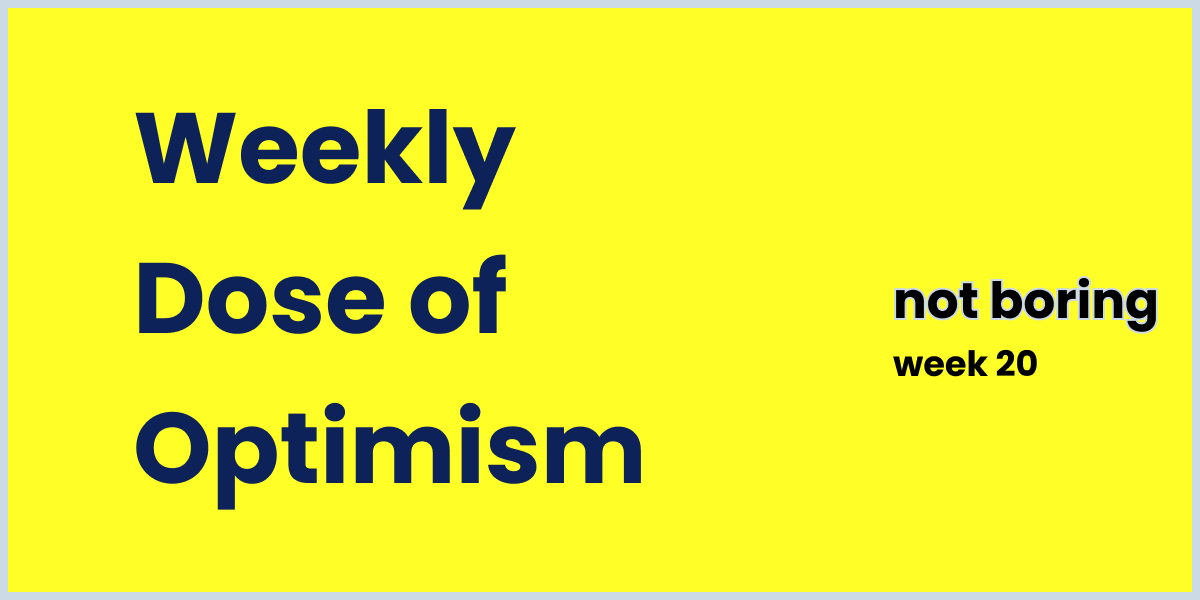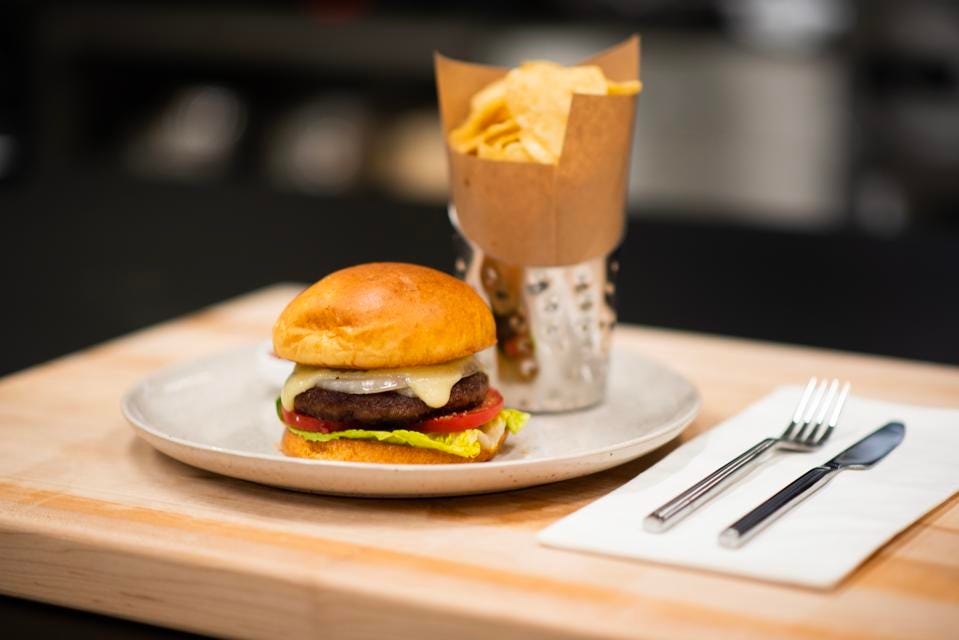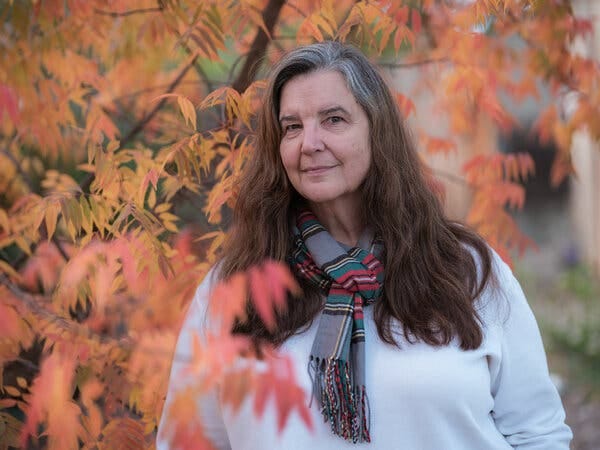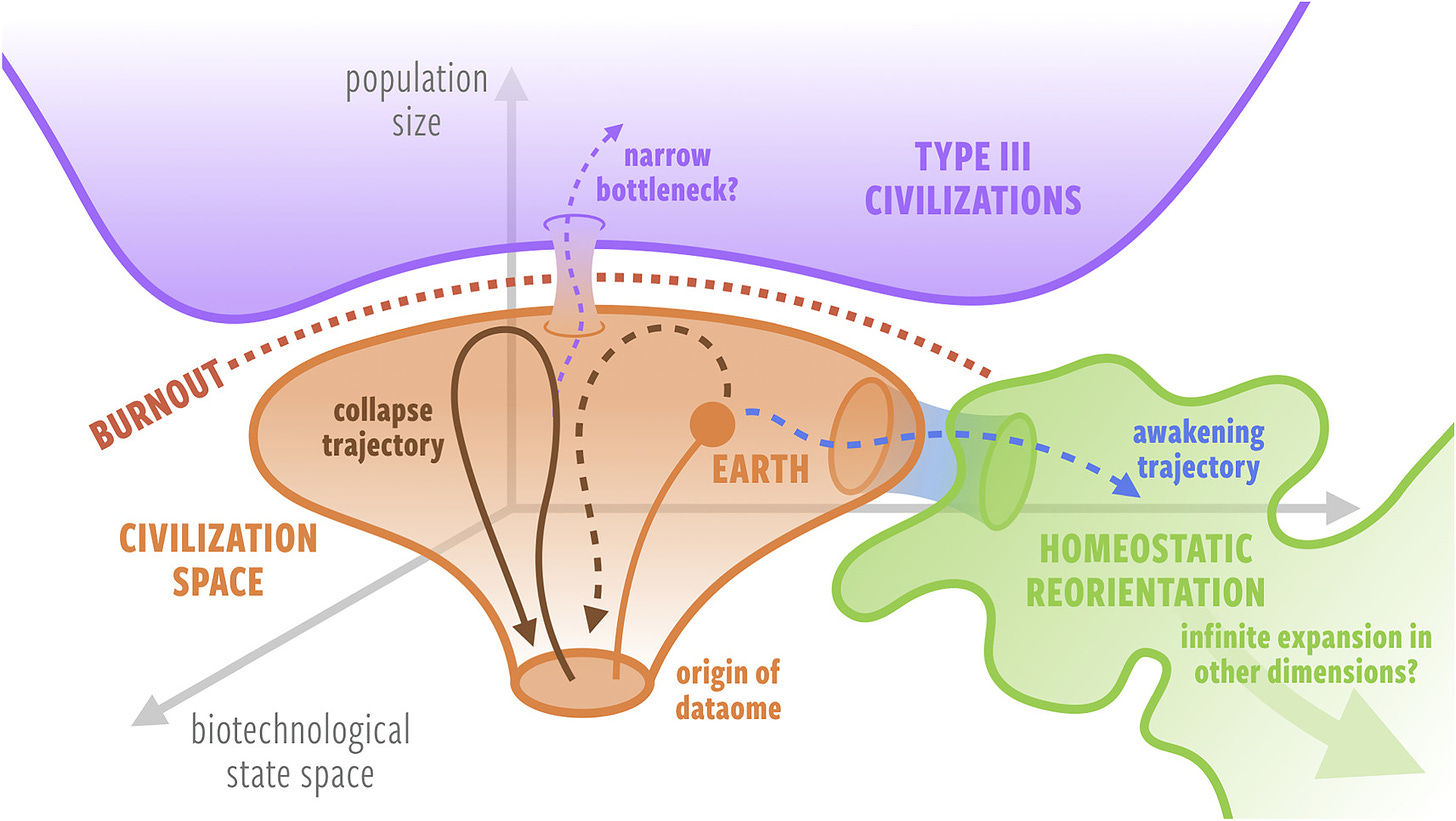

Weekly Dose of Optimism #20
source link: https://www.notboring.co/p/weekly-dose-of-optimism-20
Go to the source link to view the article. You can view the picture content, updated content and better typesetting reading experience. If the link is broken, please click the button below to view the snapshot at that time.
Weekly Dose of Optimism #20
UN Poverty Report, Abundance Recommendations, Blended Meat, Binge Eating, and Thought-to-Speech Interfaces, Anton Teaches Packy AI
Hi friends 👋,
Happy Friday and welcome to our 20th Weekly Dose of Optimism. That’s 20 straight weeks of optimism dropped into your inbox. Here’s to hoping the world gives us the content we need for the next 20!
Let’s get to it.
The Weekly Dose is brought to you by…Athletic Greens
We convinced the team over at Athletic Greens to give us an exclusive offer for our audience (legitimately, not the way people normally say that): 10 Free Travel Packs when you subscribe.
At this point you probably are familiar with Athletic Greens — it’s the easiest way to get your daily nutrients. I start every morning with a special AG1 concoction. I started taking it when my brother Dan gifted it to me two Christmases ago…which leads me to my next point: it makes a great gift. So whether you want to boost your morning routine or give a standout gift this holiday season, check out our exclusive offer below:
(1) Lifting 100 million out of poverty by 2025 still possible, despite recession threat
From The United Nations
In India, some 415 million people left multidimensional poverty in a 15-year period - a historic change - and data gathered before the COVID-19 pandemic show that 72 countries had significantly reduced poverty over recent years.
This report from the UN was released a few weeks ago, but the staggering stat of 415 million people in India being lifted out of poverty over the past 15 years is still making the rounds on the internet. 415 million people — holy shit! That means that over the past 15 years, more than one United States’ worth of people have seen a meaningful, measurable quality of life improvement just in India. There is much work to be done, both in India and the rest of the world. In India, for example, 10% of the population — or about 140 million people — still live in poverty. But despite Covid-induced setbacks, the UN believes it’s well on its way to lifting an additional 100 million people out of poverty by 2025, due to a combination of integrated poverty reduction strategies such as sanitation, decarbonization, and nutrition programs.
(2) What Policies Promote Abundance?
From The Center for Growth & Opportunity
There is reason to be deeply optimistic about the future of the US economy. Yes, at the moment we face many headwinds—shortages in labor, housing, medicine, gasoline, fertilizer, baby formula, and microprocessors continue to linger. At the same time, the rapid development of vaccines, the resiliency of digital technology and communications, and our history of innovation all point to a bright future.
The lesson of these shortages and our post-COVID world is simple: We need to build. We need abundance. With the right policies in place, America can, and will, succeed.
Abundance means greater economic growth, higher quality of life, greater environmental sustainability—all at cheaper prices. A future of abundance is not guaranteed. It is a place for conditional optimism. Meaning that if Congress takes the right steps in important areas, then abundance is within reach.
At Not Boring, we’ve written extensively on the Abundance Agenda — it’s the idea that we can (and need to) increase accessibility to essential goods by increasing supply, which means more (and cheaper) energy, production, and infrastructure. But how do we make it happen? It will require deep cooperation between government, industry, and academia. The government’s role is to reduce unnecessary red tape and provide funding, academia provides the foundational R&D, and industry commercializes and scales.
The Center for Growth & Opportunity at Utah State University is one of the leading research centers publicly advocating for the Abundance Agenda, and it recently published a list of abundance recommendations to Congress.
The authors group the recommendations into three buckets:
Technology: increase competition, improve the FDA, broadband access for all, remove barriers to transportation innovation (give me my flying car!), and expand employment flexibility
Environmental Stewardship: faster clean energy with procedural tweaks, resilient grids, proactive wildfire management, and land conservation
Immigration: expand immigration to boost entrepreneurship and build a better pathway for skilled immigration
The future is bright if the government, academia, and industry all pull in the same direction. The full piece is well worth the read for more detail on all of the above.
(3) The promise of cultivated meat
Joshua March for Noahpinion
Conventional meat has a dirty little secret: it is one of the biggest contributors to climate change. According to the UN Food & Agriculture Organization, emissions from livestock account for a startling 14.5% of all anthropogenic greenhouse gas emissions (compared to just 3.5% for aviation). And while energy production is rapidly making a transition to renewables, conventional meat consumption is only increasing (as the world’s population gets wealthier, people eat more meat)—and with it, the associated greenhouse gas emissions. Even if all energy production switched to 100% renewable power today the emissions from animal agriculture alone would still push us past the 2 degree celsius warming threshold.
People like meat. As more people are lifted out of poverty, more people will want to eat meat. Whether that “meat” is going to come from animals, plants, or a lab remains to be seen, but the planet is in trouble if it all needs to come from animals.
“Cultivated meat” — a methodology first commercialized by Memphis Foods (now Upside Foods) in which meat is cultivated from animal cells in bioreactors, is one promising source of that meat. The problem, historically, with meat alternatives is that the product either doesn’t actually taste like meat (plant), doesn’t have the structure of meat we’re used to eating (cultivated), or is too expensive to produce (both). March, the president of SciFi Foods, lays out an alternative methodology that is meant to solve each of these problems: blended meat.
Blended meat combines the flavor benefits of cultivated meat and the structural characteristics of plant-based meats. There are definitely still challenges to this approach — cost, mass appeal, etc. — but more (clean, healthy, non-animal-harming) meat is an agenda we can get behind.
(4) Pulses to Their Brains and 2 Women’s Binge Eating Went Away
Gina Kolata for The New York Times
The pilot study, funded by the National Institutes of Health and published earlier this year in the journal Nature Medicine, involves two women and will be expanded in a few months to include four more people living with binge eating disorder who regained the weight they lost after bariatric surgery. Before the treatment can be approved by the Food and Drug Administration, researchers will need to rigorously test the method in at least 100 people in multiple medical centers. Such a study would take several years to complete.
Obesity is frustrating. It’s a seemingly very solvable problem, both at the individual level and the population level. Eat less! Eat healthier! Burn more calories than you are putting in your body! But it’s obviously not so easy: over 40% of the U.S. population is obese.
Obesity, simply speaking, is caused by eating too much and moving too little. Why people eat too much or move too little can be explained by dozens of different factors including: food costs and accessibility, lifestyle choices, medical conditions, and more. About 3% of the population suffers from an eating disorder called “binge eating.” A small-scale study is using deep-brain stimulation — a methodology generally used to treat Parkinson’s patients — to curb the mental (and physical) urge to binge eat. While only two women participated in the study, they both reported no longer feeling the irresistible urge to binge. Scaling the treatment to the general population could take years, but the findings offer an interesting view into the mind-body connection and an opportunity to curb the obesity epidemic.
(5) Online internal speech decoding from single neurons in a human participant
From Sarah Wandelt et al
Speech brain-machine interfaces (BMI’s) translate brain signals into words or audio outputs, enabling communication for people having lost their speech abilities due to diseases or injury.
We’re one step closer to the future imagined by Tim Urban in The Brain’s Magical Future. A team at Caltech has devised a way to translate internal words into speech. Think a word in your head — now imagine a machine speaking that word out loud…that’s kind of how it works. Like Urban imagined, this type of BMI technology will likely help people suffering from diseases or injuries first. Imagine an ALS patient — she has full mental faculties but no ability to speak — using the BMI to communicate her needs to a nurse. And while initial use cases will likely be limited to medical treatment, you can imagine a world in which our brains are communicating synchronously with a variety of different systems that give us augmented superpowers.
BONUS 1: Thinking Together
Gordon Brander
While analyzing a global history databank spanning 10,000 years, Shin, et al found a disconcerting pattern. Civilizations scale until they are overwhelmed by the information environment they create. This is The Information Scaling Threshold.
It’s been a brutal week for crypto. FTX, which sponsored this newsletter and podcast and seemed to be one of the safest companies in the space, collapsed after using customer deposits to prop up its sister hedge fund, Alameda. There’s nothing good about the situation; it was fraud. A lot of people are reflecting on whether and why they should care about crypto anymore after another high-profile ponzi.
For me, it’s projects like Noosphere, a protocol for thought that aims to help people think together in order to solve the world’s most pressing and complex challenges.
In this piece, Gordon makes the case that we've created more information than we can make sense of with our current tools, and that the future of civilization depends on our ability to get our arms around our information environment. To pull it off, we’ll need open protocols that can respond to the complexity of that environment, and tools that merge human and AI capabilities to think better together. I’m excited to see what Noosphere pulls off, and to use the product.
BONUS 2: Anton Teaches Packy AI
On Monday, we dropped the first episode of Anton Teaches Packy AI on Youtube. The series is meant to demystify AI for curious, but not overly technical folks…like me! As of writing, we already have 420 (nice) subscribers to our Youtube channel and we’re looking to grow our following and put out more video content. The channel will be a combination of Anton Teaches Packy AI, Not Boring Founders videopodcasts, and presumably other content best suited for video. If that’s something you’re interested in, SMASH THE SUBSCRIBE BUTTON.
That’s all for this week. If you enjoyed this edition, we’d really appreciate if you shared it with a friend, family member or colleague.
We’ll be back in your inbox 9am EST on Monday morning. Enjoy the weekend.
Packy
Recommend
About Joyk
Aggregate valuable and interesting links.
Joyk means Joy of geeK




